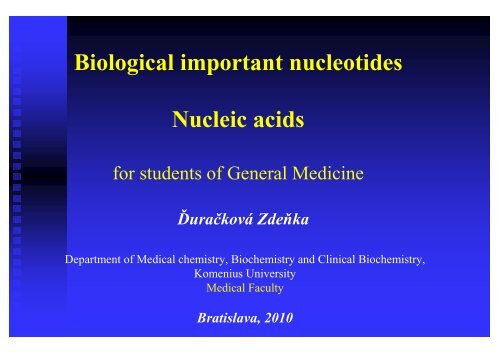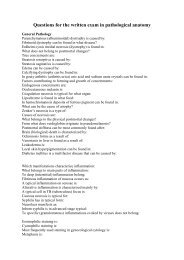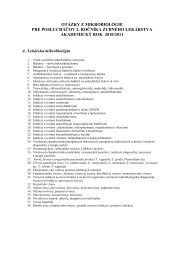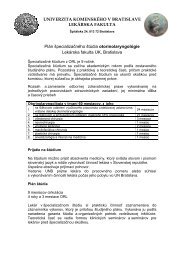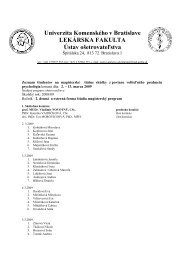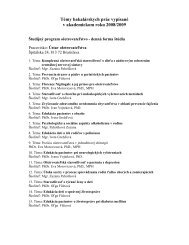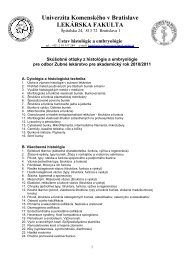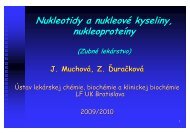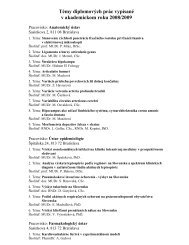Biological important nucleotides Nucleic acids
Biological important nucleotides Nucleic acids
Biological important nucleotides Nucleic acids
You also want an ePaper? Increase the reach of your titles
YUMPU automatically turns print PDFs into web optimized ePapers that Google loves.
<strong>Biological</strong> <strong>important</strong> <strong>nucleotides</strong><br />
<strong>Nucleic</strong> <strong>acids</strong><br />
for students of General Medicine<br />
Ďuračková Zdeňka<br />
Department of Medical chemistry, Biochemistry and Clinical Biochemistry,<br />
Komenius University<br />
Medical Faculty<br />
Bratislava, 2010
NUCLEOPROTEINS<br />
PROTEIN NUCLEIC ACID<br />
(protamíns, histons)<br />
nucleosid<br />
Purine and<br />
Pyrimidine bases<br />
nucleosidase<br />
(polynucleotid)<br />
mononucleotide<br />
Phosphoric acid<br />
Saccharid<br />
ribo/deoxyribonuklease<br />
mononucleotidase<br />
(phosphatase)<br />
2
OH<br />
N<br />
N<br />
OH<br />
Tautomeric forms<br />
OH<br />
laktím laktam<br />
N<br />
H<br />
N<br />
O<br />
O<br />
N<br />
H<br />
N H<br />
O<br />
5
Nukleoside Nukleotide<br />
11
β-N-glykosidic bond<br />
NUKLEOSIDES<br />
12
Nucleotides<br />
• supply for NA synthesis<br />
• biologicaly activ <strong>nucleotides</strong><br />
18
ATP<br />
AMP<br />
ADP<br />
19
The function of polyphosphates in<br />
the organism<br />
ATP - universal energetic metabolism<br />
GTP - metabolism of proteins, proteosynthesis<br />
CTP – metabolism of lipids<br />
UTP – metabolism of saccharides<br />
22
egulation:<br />
• synthesis of peptide<br />
hormons<br />
• immunological proceses<br />
• lactation<br />
• secretion of stomach juice<br />
23
+<br />
P<br />
24
NAD + + 2H NADH + H +<br />
25
Co-operation of<br />
NAD +<br />
with FAD, FMN<br />
26
alloxazin<br />
ribitol<br />
FMN<br />
H +<br />
H -<br />
FAD + 2H FADH 2<br />
27
Panthoteic acid<br />
Thioethanolamine<br />
28
NUKLEIC ACID<br />
DNA (deoxyribonucleic acid)<br />
RNA (ribonucleic acid)<br />
29
P<br />
P<br />
pentose<br />
P<br />
Sequence of <strong>nucleotides</strong><br />
base<br />
pentose<br />
P<br />
base<br />
pentose<br />
P<br />
base<br />
pentose<br />
base<br />
5´- end<br />
3´- end<br />
32
5’-end<br />
3’-end<br />
P<br />
P<br />
P<br />
P<br />
Complementary chains<br />
deoxyribose adenine thymine deoxyribose<br />
deoxyribose thymine adenine deoxyribose<br />
deoxyribose guanine cytosine deoxyribose<br />
deoxyribose cytosine guanine deoxyribose<br />
P P<br />
deoxyribose thymine adenine deoxyribose<br />
P<br />
P<br />
P<br />
P<br />
3’-end<br />
5’-end<br />
33
G<br />
A<br />
DNA<br />
T<br />
A<br />
34
Structure of DNA<br />
2 April 1953<br />
MOLECULAR STRUCTURE OF NUCLEIC ACIDS<br />
A Structure for Deoxyribose <strong>Nucleic</strong> Acid<br />
J. D. WATSON, F. H. C. CRICK<br />
NATURE,VOL 171, page 737, 1953<br />
Nobel price 1962<br />
35
Chargaff rules<br />
• DNA isolated from different animal species contains the<br />
same bases (A, G, C, T)<br />
• The relative proportionof individual bases is species<br />
dependent<br />
• The base abundance of individual species’ DNA is<br />
independent of age, diet, gender, or environmental changes<br />
• A/T = G/C = 1 A + G = T + C<br />
A + T / G + C = 1,3 – 1,5 at higher animal species<br />
36
Mutual possition of purine and pyrimidine bases<br />
in double helix of DNA<br />
Mutual possition of bases and ribose<br />
38
Double helix<br />
of DNA<br />
39
The possition<br />
of basis<br />
Base pairs<br />
per turn<br />
Helix<br />
Different kinds of DNA<br />
B-DNA A-DNA Z-DNA<br />
Zik-zak<br />
Perpendicular Skewed skewed<br />
10<br />
Right-handed<br />
11<br />
Right-handed<br />
12<br />
Lefthanded<br />
41
Superhelix<br />
DNA<br />
42
Nucleosoms<br />
(H2A, H2B, H3, H4) 2<br />
H1<br />
44
Arrangement<br />
of DNA in<br />
nucleus<br />
DNA<br />
Chromatin<br />
DNA+His<br />
Superhelix<br />
Chromosom<br />
46
NUKLEIC ACIDS<br />
DNA (deoxyribonucleic acid)<br />
RNA (ribonucleic acid)<br />
47
Minorit basis<br />
and <strong>nucleotides</strong><br />
in RNA<br />
49
Phosphoribosyl chain<br />
RNA<br />
50
m-RNA<br />
DNA<br />
Exony<br />
Introny<br />
hnRNA polyAAAA<br />
mRNA<br />
52
-RNA<br />
53
Ribosom of eukaryotic<br />
cell<br />
54
3 ’ -end<br />
5 ’- end<br />
Anticodon<br />
t - RNA<br />
CCA –AA-binding site<br />
55
t-RNA<br />
O<br />
Ester bond between<br />
-COOH of AA and<br />
-OH group of ribose<br />
O<br />
P<br />
O -<br />
O<br />
Bonding of AA to 3´-end of t-RNA<br />
CH2<br />
O<br />
O OH<br />
Cyt<br />
R<br />
O<br />
P<br />
O -<br />
C<br />
O<br />
NH2<br />
N<br />
CH2<br />
C O<br />
aminoacid<br />
NH2<br />
N<br />
O<br />
O OH<br />
N<br />
N<br />
3´- end of t-RNA<br />
57
Codon - anticodon<br />
complementarity<br />
58
Codon - anticodon<br />
complementarity<br />
Ala<br />
59
Codon - anticodon<br />
complementarity<br />
Ala<br />
60
Ending of<br />
translation translation<br />
61
1977 – Primary structure of bacteriophage<br />
Nucleotide transcription in DNA 1 page<br />
Nucleotide transcription in DNA of E. coli<br />
1 book (800 pages)<br />
Nucleotide transcription in human DNA<br />
800 books<br />
62
Lenght of all DNA in human<br />
• 1,2.10 10 base pairs – 4 m long chain in 46 chromosomes of one cell<br />
• Number of cells in the organisms = 10 13<br />
• Lenght of DNA in the organisms of all cells = 4.10 10 km<br />
• Distance of Earth from Sun = 1,5 . 10 8 km<br />
• The lenght of all DNA in human is 100x more lenght than<br />
distance of Earth from Sun<br />
63


